Why are people so damn good at asking the wrong questions?
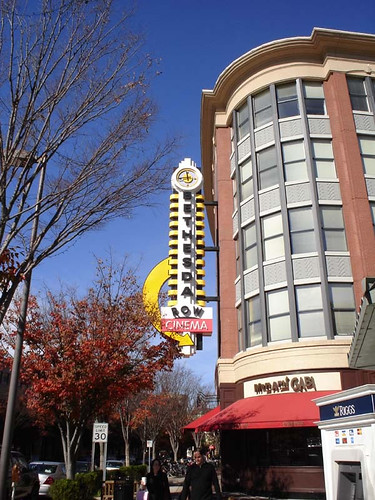
In "New Bethesda," which extends between Bradley Boulevard and Old Georgetown Road a grassy expanse has given way to Bethesda Row, a bustling strip of shops, trendy restaurants and a new movie theater. Photo by Carolyn Murphy. From the AU Student newspaper.
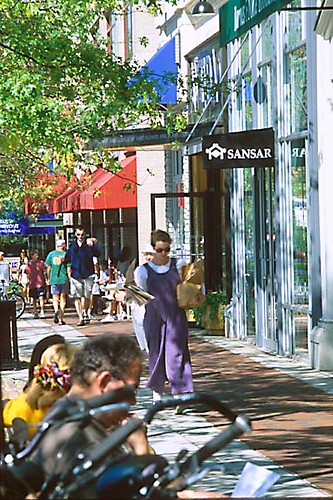
Bethesda Row. CNU photo.
Today's Examiner has an article and an editorial about the Metro West development in Fairfax. The article, "Senator: Few who live near Metro use it" says that few people in the area around the Vienna station walk to it. (They weigh in with an editorial that says the proposed development is too dense, "MetroWest is too much.")
This is a shock?
Have you ever been to any of the last stops on the various Metro lines?
They are desolate, disgusting places. (Glenmont isn't that desolate compared to the others, but it's not a pedestrian-oriented area in any case.)
I would be terrified to walk to the station. How many people even live nearby? Are there sidewalks and easy ways to get to the station?
But that shouldn't be a surprise, because out there, the stops are more like station stops on a railroad line. There is nothing urban and dense about these places. And they certainly aren't places conducive to fine pedestrian experiences.
At least this makes me feel better, that Virginia, not just DC, has some people as elected officials who aren't that swift... Ironically, the same issue of the Examiner has articles on mixed use development in Maryland, "Moving on up" about Prince George's County, and in Arlington, "Arlington approves condo project." Not everyone is tone deaf I guess.
I don't really want to get in the business of helping Fairfax County become a better place. It's all that we can do to try to make DC a better place. (Of course, we have Tom Davis to deal with too, just like Fairfax County.)
But I think State Senator Davis--Tom Davis' wife-- needs to read the Fairfax County planning report that I found last week, The Vanishing Land: A Plan for Preserving Open Space that was produced in 1962! When you have a development paradigm that is completely sprawl-based, it's going to be tricky "going backwards" and retrofitting appropriate density, at least in the beginning.
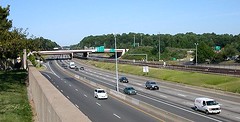
Interstate 66, looking east from Vienna Metro Station. Image from Virginia Places. Not too walkable....
Bethesda Row is a good example for Fairfax, not that it is a perfect example*. Unlike the area around the Vienna Metro Station, Downtown Bethesda has traditional urban design antecedents, but they had been supplanted in many cases, by planning for the car. Bethesda Row anchored by a Barnes and Noble, movie theaters and popular restaurants like Jaleo, has created a new center for the community (note by the way the very big difference between Bethesda Row and what I think of as very antiquated thinking in terms of the urban renewal oriented projects in Silver Spring). (* the urban conglomeration of Bethesda is more like the City of Falls Church, if Sen. Davis needs an example closer to home.)
Sure people have to drive to it, but once they do, they park in an interior-block parking structure, and get around the area by foot, partaking of the various experiences and the great street.
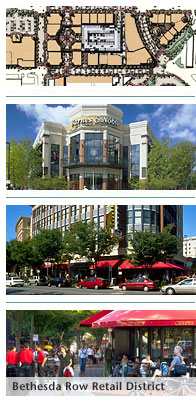
Image: Cooper Carry. From the Cooper Carry website:
An excellent example of Cooper Carry's ability to bridge the public and private, Bethesda Row has rejuvenated downtown Bethesda, a transition district just outside Washington D.C. Set between a commercial core and several single-family neighborhoods, Cooper Carry undertook the redevelopment of an under-performing six-block district and masterplanned it for retail, office and residential mixed-use developments.
The masterplan was designed around an existing public parking garage. Thanks to a local tax innovation, local businesses pay parking taxes that the county uses to build parking garages and create Business Improvement Districts (BID). This created opportunities to add greater retail and entertainment spaces, including a multiplex arts theater. Two office buildings anchor the Bethesda project. The Jennings building is a single loaded, Class A office space built alongside the parking garage... The Woodmont East office building offers four floors of Class A corporate space over street retail and underground entertainment facilities. The attractive mixed-use environment was an immediate draw for corporate business. A major corporate technology tenant occupies three of the four office floors.
Successfully targeting a mix of local and national retailers and small businesses, the firm achieved its goal of drawing people into the neighborhood who might make it their home, not just their office. The result was the creation of a remarkably pedestrian-friendly environment that attracts people from each neighboring community. Wide sidewalks cut through a tree-lined corridor of outdoor cafes, shops, restaurants, offices, apartments and entertainment venues. The unique urban character of the new buildings mirrors that of the older buildings in Bethesda, and fountains and public art have helped create an inviting pedestrian environment and colorful, bustling center of urban life.
____________________________
Note: this is why I say that DC:
(1) can't afford to rest on its laurels;
(2) needs to focus on what makes cities great, and extend and nurture these competitive advantages (architecture, history, independent retail);
(3) because it doesn't matter that DC does better than Baltimore or Cleveland or Detroit, etc.;
(4) because our primary competitors are Alexandria, Arlington, and Montgomery County;
(5) our local competitors have plenty of developers ready to do pro-urban design pro-placemaking projects;
(6) meanwhile we throw away such opportunities in our own city.
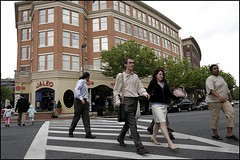
The other end of the complex depicted above. People walking in Bethesda. Washington Post photo by Marvin Joseph.
Labels: transit, urban design/placemaking



0 Comments:
Post a Comment
<< Home